Last Updated on January 10, 2024 by Greg Gillson
Barred Owls are one of 5 species of owls that can be found commonly in residential backyards in some areas of the United States.
Barred Owls are larger than Barn Owls but smaller than Great Horned Owls. If you have large trees in your yard and live near a forested ravine or swamp, you may be able to attract Barred Owls to your yard with a nest box.
Barred Owls are found in forests, especially near water, from eastern Texas to Minnesota eastward in the United States to Florida and Maine. They are also found in southern Canada from Newfoundland to Manitoba. They then are found in mid Saskatchewan and Alberta and throughout much of British Columbia, SE Alaska, and the Pacific Northwest to northwestern California.
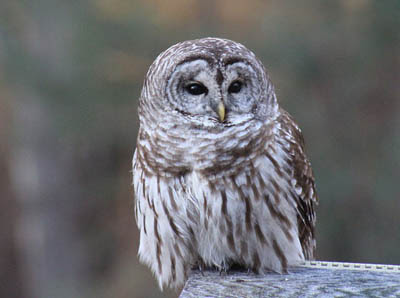 |
|
Barred Owl
Image by mpmochrie from Pixabay
|
What makes your yard attractive to Barred Owls?
The typical habitat of Barred Owls includes mature deciduous or mixed woods. Locations can include canyon streams with big trees, wooded ponds, even forests with a closed canopy hiding the sky and more open underneath. They occur in wooded parks in towns, but especially river edge forests.
They stay deep in the wet woods on big limbs in the shadowed canopy under the big trees.
Does this sound like your backyard? If so, and you live in the regions mentioned above, you may be able to attract Barred Owls to your yard!
There should be nearby woods for these owls to hunt in that remain dark at night. There should not be too much people and machinery noise during the day. To keep the owls safe from vehicles, don’t put owl boxes too near a busy highway.
Barred Owls are large predators. They have been known to kill and eat housecats. It is possible that a nesting owl may attack small dogs. Such a thing would be very rare for this species of owl. But it is something to consider before attracting Barred Owls to be daily residents of your backyard.
This owl doesn’t actively go out and fly around seeking your favorite pet as prey. It sits on a perch and waits for small animals to pass by.
Thus, it isn’t likely to harm small dogs going outside for a potty break before bed–especially if you turn on the lights. It’s not impossible, just not very likely that a Barred Owl would attack your dog.
Cats roaming around at night seeking rodents will put them in the path of hunting owls, though.
Barred Owls have been known to fly at or strike people in the head with their claws if they get too close to the nest. It seems that early morning joggers in the forest parks are the main victims! Often the owls don’t make actual contact. Sometimes they knock people’s hats off! Rarely do they draw blood.
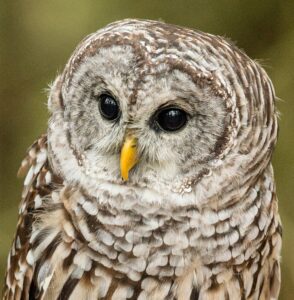
Barred Owl nests in nature
Typically, Barred Owls nest in tree cavities. These are usually quite high, 20-40 feet above the ground. They may also use old stick nests of hawks and ravens.
As with most owls, they really don’t add much to the nest. They may trample or flatten old hawk or owl nests to make them more suitable. They rarely add lichens, a conifer twig, or a feather or two to the nest.
Courtship begins in February. Nesting continues through August. Barred Owls call all year and vigorously defend their territory against other Barred Owls.
Barred Owls lay 2-5 eggs, 3-4 typical. They only breed once during the nesting season. Females incubate 28-31 days. Once they hatch, the nestlings remain in the nest 28-35 days before fledging.
The Barred Owl nest box
Natural cavities in older trees in a mixed forest are a bit in short supply in most places. Thus, Barred Owls will readily accept an artificial nest box.
Barred Owl nest box dimensions
Barred Owls can use a large Barn Owl house. In fact, the larger size the better for Barn Owls. So both types of owls can use a nesting box designed for the Barred Owl. The Barred Owl prefers a slightly larger entrance hole. The Barn Owl might like a larger floor size.
The floor should be about 12×13 inches. The box should be about 24 inches tall. The nest box entry hole should be 7×7 or even wider at 7×8 inches.
Whether you make a nest box following plans and designs, or purchase one pre-made, try to use these dimensions.
Barred Owl nest box dimensions overview
- 12×13 inch floor (minimum)
- 24 inches tall (minimum)
- 7×7 inches (or wider) entrance hole at least 13 inches up from the floor
- 15-25 feet high off the ground
Some kind of exercise shelf or perch outside the box is desirable for the chicks to use as they get larger and start to explore their world.
The older chicks will venture out of the box before they are ready to be off on their own. Thus, it would be good to have a branch near the nest box so that the young can fly-hop and get back in the box at night.
Do not place more than one nest box in the immediate area. Barred Owls are very territorial as previously discussed. Keep owl boxes at least 1/2 a mile apart.
Add 3 inches of wood shavings to the bottom of the box. You may also use clean leaves and moss.
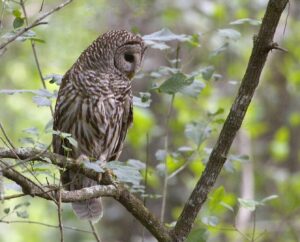
Barred Owl nest box placement
Nest boxes for Barred Owls must be placed within the dense forest, not on the edge. So don’t place a nest box on a building or a bare pole.
Inside the woods the direction the Barred Owl house faces doesn’t matter as much. The entrance hole should face away from the prevailing rain direction, if possible.
The height of the nest box is not overly critical. Anything over about 15 feet in height should be fine. One person mentioned how he placed nest boxes on trees on the side of a ravine. The nest box was attached and faced downhill, so it seemed higher on the stream side of the tree.
Keep raccoons from taking over the nest box. They may use it themselves. They may eat the eggs or nestlings. Place a predator guard all around the tree trunk using metal flashing. Place this at least 6 feet high on the tree. Place it higher if people are likely to damage it.
It is best for the owl chicks to have branches near the nest box. They can practice flapping and fly-hopping through the tree and make it back to the nest box at night. The longer they stay at the nest site before fledging the more likely they are to survive.
However, there should be a clear flight path straight into and out from the nest box. Adult owls flying directly into the nest hole shouldn’t encounter any other trees, branches, or leaves for at least 20 feet from the front of the nest.
The nest should ideally be in a hardwood (maple, ash, hickory or similar large branching tree). One should try to makes sure there is a dense evergreen, such as a hemlock, nearby. Owls can approach the nest area unseen and hide or roost in this dense conifer.
Remember, the female incubates the eggs and chicks. The male remains outside the nest during the day (and night) and brings food to the mother and young.
Nest box competitors and maintenance
Winter is probably the best time to put up an owl nest box. Even so, it seems that Barred Owls may find a nest box while prospecting in winter or spring, yet wait an entire year to actually use the box.
Thereafter, they generally use the same nest site as long as it is in decent shape.
However, if owls don’t move in right away, other animals might. Wood Ducks may compete with Barred Owls for the nest box. Squirrels and raccoons will also want the box. A predator guard should deter the raccoons. Squirrels may be the hardest to keep out.
You may wish to examine older boxes in December. Clean out any squirrel nests. Use a mirror on a stick and flashlight to make sure the owl box isn’t inhabited by an owl or raccoon before you open it up. It could be dangerous for you to have an animal jump out of the nest box while you are 20 feet up on a ladder!
Barred Owls might not make as much of a mess of their nest as some other owls. So cleaning the nest box yearly isn’t always necessary. However, there could be eggs that didn’t hatch or dead chicks or prey that didn’t get eaten. Squirrels could have filled the box with leaves. So it’s best to at least check.
When you clean out the nest box you can add 3 inches of wood shavings.
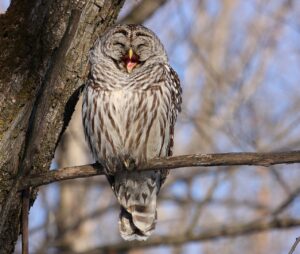
Wrapping Up
Forest Favorites:
- Deciduous forests: These leafy havens with tall trees offer excellent hunting grounds and plentiful nesting sites for barred owls. Look for them roosting in cavities or hidden amongst branches.
- Mixed forests: Blending deciduous and coniferous trees provides diverse opportunities for barred owls. They readily utilize both types of trees for shelter and hunting.
- Riparian forests: Following rivers and streams, these vibrant forests with abundant prey attract barred owls, especially in southern regions. Listen for their haunting calls echoing through the trees.
Beyond the Forest:
- Woodlots and groves: Even smaller forested patches can attract barred owls, especially if they offer open areas for hunting nearby. They might nest in tall trees or even abandoned buildings within these pockets of woods.
- Parks and urban edges: Adaptable barred owls sometimes venture into parklands and fringes of urban areas, particularly if sufficient trees and prey are available. Keep an ear out for their calls at night on the outskirts of cities.
- Mountain forests: In higher elevations, barred owls find suitable habitat in coniferous forests and rocky canyons, making them surprisingly versatile mountain dwellers.
Habitat Clues:
- Listen for their calls: The iconic “who-cooks-for-me-hoo” call of the barred owl is a good indicator of their presence.
- Look for signs of activity: Owl pellets, feathers, or scratches on trees can reveal their territory.
- Spot their silhouettes: With sharp eyes, you might catch a glimpse of their tawny brown bodies and round eyes peering from a branch at dusk or dawn.
Frequently Asked Questions
How rare is it to see a Barred Owl?
While Barred Owls are not considered rare or endangered, seeing one can be quite challenging! Here’s why:
Nocturnal Habits: These owls are primarily active at night, spending their days roosting in dense foliage or tree cavities. This makes spotting them during the day a matter of sheer luck.
Camouflage Masters: Their streaked brown plumage blends perfectly with bark and leaves, making them incredibly difficult to detect even when you’re up close. Their round eyes further camouflage them against tree trunks.
Solitary Hunters: Unlike diurnal hawks and owls, Barred Owls are solitary creatures. They typically hunt and perch alone, further reducing your chances of encountering one unless you stumble upon their territory by chance.
Dense Habitat Preference: They favor thick forests with plenty of cover, which might limit your visibility even if you’re within their territory.
However, not all hope is lost! Here are some tips to increase your chances of catching a glimpse of these enigmatic birds:
- Go birding at dusk or dawn: As they transition from night to day or vice versa, you might be lucky enough to see them flying between their roosting and hunting grounds.
- Listen for their calls: Their distinctive “who-cooks-for-me-hoo” call is surprisingly loud and carries far through the night. Use it to pinpoint their location and follow the sound.
- Visit known habitat: Focus on mature forests with a mix of tall trees and dense undergrowth, especially near water sources.
- Stay still and quiet: Their keen senses of hearing and vision make them incredibly perceptive. Be patient and avoid making noise that might spook them.
- Join a guided birding trip: Experienced birders familiar with owl habitats can significantly increase your chances of seeing one.
Are Barred Owls friendly to humans?
Barred owls are not considered “friendly” towards humans in the way that some animals like dogs or cats might be. They are wild animals with strong instincts for self-preservation and predatory behavior. While they rarely directly attack humans, there are reasons to maintain a respectful distance:
Wild nature: Their primary focus is survival and hunting, not interacting with humans. They can react unpredictably if humans come too close, especially near their nests or territories.
Fear and defense: Like any wild animal, they might feel threatened by human presence and act defensively, which could involve hissing, snapping their beaks, or even swooping down if they feel cornered.
Bird of prey: Their sharp talons and beaks are meant for hunting and can inflict serious injuries if they feel threatened. Even during incidental contact, their natural defensive reactions can be alarming.
Territorial behavior: They fiercely defend their territories, especially during breeding season, and might perceive humans entering their space as a threat, leading to aggressive displays.
However, it’s important to remember that:
Unprovoked attacks are rare: Barred owls generally avoid humans and prefer to flee rather than confront them. Most reported incidents involve individuals approaching owl nests too closely or inadvertently surprising the bird.
Important role in the ecosystem: They play a crucial role in controlling rodent populations and maintaining the natural balance. Appreciate their ecological significance from a respectful distance.
Why do Barred Owls scream at night?
The chilling screams of Barred Owls echoing through the night can send shivers down your spine, but they’re not just trying to give you nightmares! These screams, unlike their more familiar “who-cooks-for-me-hoo” calls, serve various purposes in their owl-y lives:
Territorial Defense: One of the primary reasons for screeches is territory marking. A loud scream signifies ownership, warning other owls to stay away from their hunting grounds and nest sites. It’s like an aerial “keep out” sign, preventing intrusions and potential conflicts.
Attracting Mates: During breeding season, males might use louder, more drawn-out screams to attract potential mates. Imagine it as their version of a romantic serenade, showcasing their strength and fitness to impress a female owl.
Communication with Young: Owls use specific vocalizations to communicate with their young, and screams can be part of this repertoire. They might signify danger, call their chicks back to the nest, or simply signal their location in the darkness.
Expressing Alarm or Distress: If Barred Owls feel threatened by a predator, human presence near their nest, or any perceived danger, they might emit short, piercing screams. It’s their way of raising the alarm and communicating distress to their partner or chicks.
Unidentified Reasons: Sometimes, even experienced birders struggle to pinpoint the exact reason behind a Barred Owl’s screams. There could be various environmental factors at play, or they might simply be expressing emotions not fully understood by humans.
You may like: 5 Common backyard owls






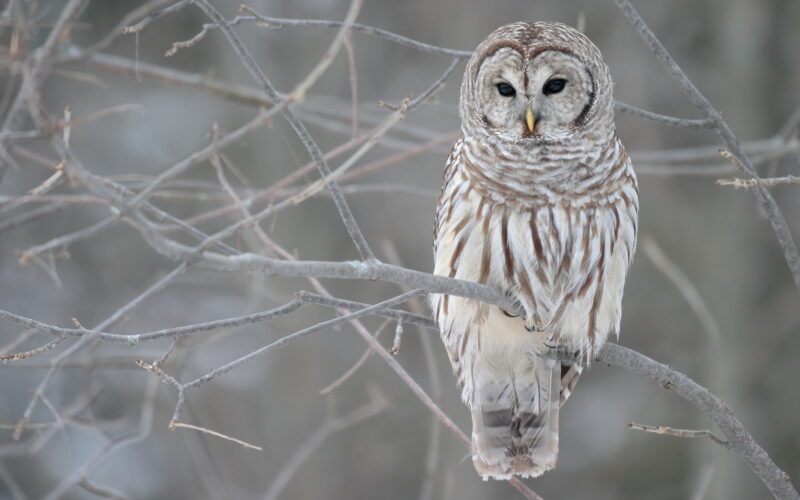
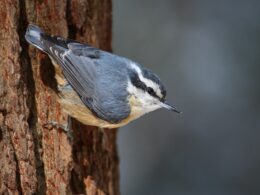
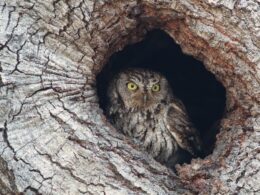
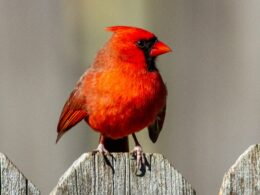
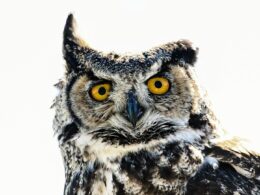
Thanks for a great article and video on Barred Owls and their habitat needs. Love your sense of humor! For Do-It-Yourselfers, it would be helpful to include a drawing with dimensions of your Barred Owl nesting box. I'm going to share this on Nextdoor.com with neighbors who love having owls live in their community, but aren't aware of their habitat needs.
Thanks, Rose!
Thank you for this article. I'm actually in the process of trying to attract barred owls. I have trees in my backyard about 75 ft from my house the trees back into a grassy swampy area and a creek about 500ft away.i already built an owl house similar to the size you suggested. My challenge is how to get it up the tree. The trees are mostly cottonwood with some maple. I've been playing bared owl sounds on my deck hoping to help attract them.
How exciting! It is getting the time of year when owls might start scouting for nests. I don't have any suggestions for getting up into the tree. Scaffolding? What ever you do, be safe climbing up there!
Also, my dog is 25 pounds and he goes out in my fenced yard, unsupervised. Is he small enough to be in danger? And we have seen red shouldered hawks.
I would be cautious in the evening or night for the owls, but not overly worried.
Remember that birds are light-weight. Even the large Great Horned Owl barely weights 3 pounds. Great Horned Owls can take prey items up to 3 times their weight, or about 9 pounds (rabbits and smaller).
It would be highly unusual for an owl to try to attack a dog more than 10 pounds.
However, if any wild animal gets trapped by a dog, then they will fight to get away.